WWE: Ric Flair - The Definitive Collection
Introduction:
In the wrestling industry, when it is said that "there will never be another Ric Flair", it's a turn of phrase that is meant both literally, as well as figuratively. Literally, because Flair was a unique wrestler with a unique appeal, and figuratively because the wrestling industry that Flair was at the top of across three decades, is remarkably different now, as compared to 25 years ago.
Back in 1983, when Flair won his second World championship - the first is actually less well remembered than the second - the global power in wrestling was not the WWF (now WWE), but the NWA (National Wrestling Alliance), a large group of promoters which at times also encompassed Vince McMahon Snr's New York company. The NWA champion was considered to be the World champion, and that person defended the title in numerous wrestling "territories", which were all run by a different promoter.
Although Bret Hart would likely dispute that his 1990s run with the WWE title had even more of an international flavour, Flair's 10 NWA Title reigns - which incredibly saw him wrestle virtually every night of the week, and often twice on Sundays - beginning in 1981, truly make him the last touring champion in wrestling history. When Ted Turner created World Championship Wrestling from what had been Georgia Championship Wrestling, to compete with Vince's McMahon's WWE, the concept of the touring champion was lost, likely forever.
"Ric Flair: The Definitive Collection", then, is a look back at the legacy of Ric Flair, charting his career from his early days training with Verne Gagne, to his WWE retirement in 2008. With a documentary the main feature, there are a host of extras, including matches and interviews, across these three discs.
Video:
Video is presented in 4:3 fullscreen PAL, and is very good for a DVD of this genre. This is a crisply-edited documentary, which makes use of the WWE's stunning wrestling video library, which contains decades worth of footage from the NWA, AWA, and WCCW, to name but a few.
Though there is a warning upon playing the disc that "there may be slight imperfections" in the video due to the source material, I found the footage used to be in remarkable condition - a miracle considering the way in which much wrestling footage was treated over the years. The new interview footage, with the likes of WWE executive Michael Hayes, perennial champion Triple-H, and Shawn Michaels, looks as excellent as you would expect.
The transfer to DVD is kind, with little noticeable in the way of digital artefacts.
Audio:
Audio is presented in Dolby Digital 2.0, and is also very good. This is a pleasant mix of near-constant interview footage and generic-but-acceptable background music, the latter of which never intrudes on the former. The interview audio is clear at all times.
There is a further 2.0 track available in French.
Extras:
With extras pervading all three discs here, there's enough to keep any wrestling fan much amused.
Disc One begins with some deleted scenes from the documentary, as Flair tells stories about how his lavish spending began with his first purchase of wrestling boots, wanting to be known as "Ramblin'" Ricky Rhodes, and what it was like to be part of the Evolution group in the final years of his career. The best story, however, regards his admiration of Dusty Rhodes and Dick Murdoch, and how he spent time with them on the wrestling road.
Also on Disc One, there's an excellent music video dedicated to Flair, which uses an unbelievable amount of varying Flair footage, from throughout his entire career. The track used for the video, "Leave The Memories Alone" by Fuel, is particularly fitting.
The wrestling action gets underway on Disc Two, as Flair refuses to defend the NWA Heavyweight Title on Mid-Atlantic television, only for his hand to then be forced by legendary wrestler Jack Brisco. The two then engage in an excellent TV match, in an era (1982) when contests of this magnitude did not take place on television.
In a match from Dallas, Texas, again in 1982, Flair defends the NWA title against Kerry Von Erich. A 2/3 falls match, this is Flair at his peak, taking the often-sloppy Von Erich to a tremendous bout, even if the finish is a little lame.
Flair reverts to the role of challenger one year later, as he squares off against perennial nemesis Harley Race. This bout led up to the famous bout between the same two men at Starrcade 1983, but I found this TV match from Mid-Atlantic Wrestling to be better-paced and rather more enjoyable than that match, held three months later. Those who remember Race from his later WWF stint, will be surprised at his athleticism here.
The first appearance of the Four Horsemen team is next, as Flair and Arn & Ole Anderson face Dusty Rhodes, Magnum T.A, and Manny Fernandez. The crowd reaction in the arena is incredible during the bout, which only stands to make this fast-paced encounter even more exciting.
The 1988 bout with the debuting Sting is a prime example of why Flair is considered one of the very best wrestlers of all-time. In this 45-minute contest, the athletic but inexperienced Sting has one of the best matches of his career - something he assuredly could not have done with Flair being in the opposing corner. Largely due to Flair, there was a real belief that the "rookie" Sting could win the title on that evening.
The final bout of this disc sees Flair face Terry Funk, his first opponent after the legendary 1989 series against Ricky "The Dragon" Steamboat. Some fans may be disappointed to note that this is not the famous "I Quit" match against Funk, but rather the pay-per-view bout previous to that. However, this is also an excellent, brawling-style bout, equally notable for Funk's unique style.
We then skip two years to the first bout on Disc Three, and indeed move from the NWA/WCW to the World Wrestling Federation, as Flair contends with "Rowdy" Roddy Piper. This is very much a WWF-style contest, a type of wrestling that Flair quickly adapted to, so while this match is certainly entertaining, it's far from a Flair-Race classic.
It's a delight to see the 1994 bout against Ricky Steamboat available here, especially considering the fact that it has never been available commercially on DVD. It's a fine bout, albeit a little slower than the classics of their heyday, and is a fitting way to conclude their remarkable rivalry.
We fast-forward 11 years next, as Flair faces protégé Triple-H in a Steel Cage match at the Taboo Tuesday pay-per-view in 2005. This is one of the last great matches of Flair's career, and it's also certainly one of the bloodiest he ever took part in. You'll be hard-pressed to find a more dramatic cage match in recent wrestling years.
The final bout available here is from 2008's Wrestlemania show, as Flair puts his career on the line, against Shawn Michaels. This is a tremendously-paced bout, which lived up to the hype that it received in the build-up to the WWE's biggest show of the year.
Even after the matches, the extras aren't finished on Disc Three, as we get a look at the closing segments of the Raw television show, during which Flair is honoured for his contributions to the wrestling business. One of the classiest moments in wrestling TV history, this DVD really wouldn't be complete without it.
Furthermore to all of this, we have a series of Flair interview segments, taken from 1985 to 1987, at a time when NWA World Championship Wrestling was taped in a small TV studio. Each of the 10 segments here is classic Flair, showing off why he is still considered one of the best interview men in the business.
Main feature:
Though it isn't my intention to be at all negative in this review, there's something that I just have to point out from the get-go; two hours of documentary simply isn't enough to tell the story of the great "Nature Boy" Ric Flair.
To be fair, I suppose, it would take closer to ten hours to begin scratching at more than the surface, and that really isn't feasible here. But you cannot help but feel that even an extra hour would have helped to have done justice to perhaps the greatest career in the modern era of professional wrestling.
But now that that's out of my system, we can get to the great and the good, because there's little that dips below that standard throughout the course of this main-feature documentary.
As is the case with most WWE DVD documentaries, there's a fine line here between a profile of the Richard Morgan Fliehr, the person, and Ric Flair, the wrestler. Each end of this feature - the start and finish - tells more of the former, while the middle focuses in on the wrestling feuds and stories that made him famous. The move from Flair's childhood - which, due to the stolen babies scandal of the Tennessee Children's Home Society, is fascinating - to his wrestling career, however, is exceptionally quick, as it only takes four minutes of the feature for talk to turn about his training to be a pro wrestler.
The 1975 airplane crash - which doctors said should have ended his career - is covered here in some detail, which leads into how Flair went from wearing tie-dye like "Superstar" Billy Graham, to becoming the "Nature Boy", just as wrestling pioneer Buddy Rogers had been previously. From there, we see Flair becoming the NWA World Heavyweight champion, and feuding with the likes of Sting, Ricky Steamboat, and Terry Funk.
After that, Flair's move to the WWF in 1991 is covered, though it does not explain his problems with WCW head Jim Herd in the detail that perhaps they deserved. There's then the ill-fated return to WCW in 1993, before WWE purchased the company in 2001, at which point Flair found himself back working in New York.
With so much to be covered in just a two-hour documentary block, it is understandable that it is the most famous moments of Flair's career that take precedence here. And all things considered, this story is told in as much detail as it could have been given the time constraints. Hardcore fans will lament not hearing the stories that are told in Flair's book - such as "losing" the NWA Title to Jack Veneno in the Dominican Republic - but that's perhaps a little much to ask.
The major triumph of the documentary is perhaps its quite remarkable use of archive footage. As a means of telling how Flair first fell in love with the business, there's footage from the 1960s and 70s here, and from there, the 1980s footage - in particular from Mid-Atlantic Wrestling and Georgia Championship Wrestling - goes into overdrive in the form of in-ring highlights, and incredible interview segments with the man himself. The WWE's archivists deserve incredible credit here, as even clips of this footage on a DVD medium would have previously been enough to make Flair fans believe Christmas had come early.
Aside from comments from Flair, there are lots of words from current WWE personalities, such as Jim Ross, John Cena, Shawn Michaels, and Triple-H. It's also fantastic to hear from the legends of the industry, such as Harley Race and Jack Brisco, who were actually there at the time, experiencing all that Flair experienced himself. Furthermore, hearing from Flair's children as to what it was like to grow up without their famous father - who toured almost all-year round - is emotional to say the least.
The story of Ric Flair is a great one, but there's no denying that this presentation makes it all the more accessible.
Conclusion:
"Ric Flair: The Definitive Collection" not only affords wrestling fans a historic look at the career of perhaps the greatest professional wrestler of the modern era, but it also provides some incredible footage, that has never previously had a commercial release. Weighing in at over 8 hours of tremendous footage, every moment captured is a joy to visit or even revisit, as many fans (myself included) will no doubt do sooner rather than later.
The previous three-disc Flair set, "The Ric Flair Collection", showcases other famous matches that are not available here, such as the 2/3 Falls match with Ricky Steamboat from 1989, the "I Quit" match with Terry Funk from the same year, and the 1992 Royal Rumble during which Flair continued his legacy under the WWF banner.
Together with that release, there's enough Ric Flair to keep most fans happy for a long, long time.
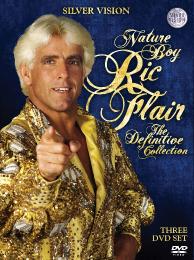
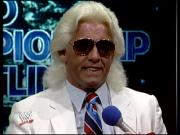
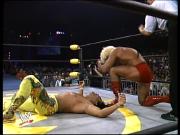
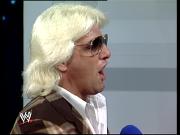
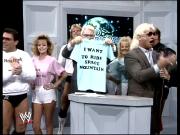

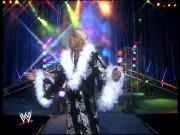
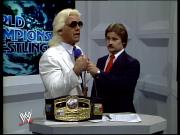




























Your Opinions and Comments
Be the first to post a comment!